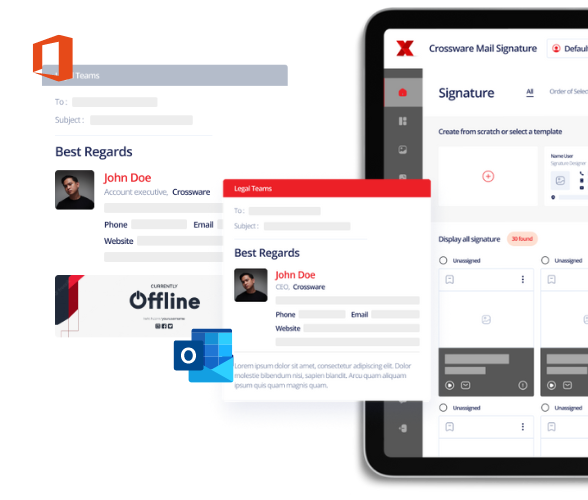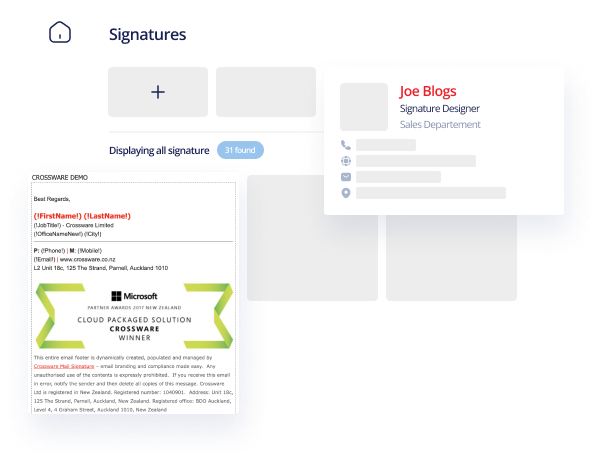
In today’s digital age, the coherence and clarity of your email signatures are not just a detail but an integral part of your professional persona and brand identity. An effective email signature offers a snapshot of your professional identity and, if managed skilfully, can enhance communication efficiency and brand consistency. Yet, many professionals overlook the strategic potential of optimised email signatures. Considering the various components—from essential contact information to social media links and legal disclaimers—the question remains: how can you streamline your email signatures to maximise their impact and utility? This discussion invites you to explore strategic practices that could transform your email signatures into powerful tools for professional communication.
Key Takeaways
- Utilize email signature management tools for standardised deployment and automated updates.
- Create responsive signature designs to ensure readability across all devices.
- Incorporate essential contact information, social links, and a professional image to enhance brand consistency.
- Implement confidentiality clauses and legal disclaimers to meet compliance and protect data.
- Regularly audit and update signatures to maintain accuracy and relevance.
Importance of Uniform Signatures
Uniform email signatures consistently reinforce a company’s brand identity, fostering recognition and professionalism. When employees use a standardised signature format, it not only enhances the visual coherence of communications but also promotes brand consistency. This uniformity guarantees that every email sent is a reflection of the company’s values and professional image, which is essential in maintaining a consistent brand experience across various customer touchpoints.
Adhering to signature etiquette is another important aspect of maintaining this uniformity. It involves setting clear guidelines on what elements should be included in the signature, such as the employee’s name, position, and contact information, as well as the company’s logo and any legal disclaimers. This not only helps in keeping the signatures concise and relevant but also aids in avoiding the clutter that can detract from the message’s professionalism.
Designing a Professional Signature
Having established the importance of uniform email signatures, let us now explore how to design a professional signature that effectively communicates your role and company identity. Designing a professional email signature requires careful deliberation of various elements that can enhance or detract from your professional image. Here are key components to contemplate:
- Name and Title: Clearly state your full name and professional title. This simple act guarantees immediate recognition and establishes your position within your organisation.
- Contact Information: Include only essential contact details such as phone number, email address, and company website. This keeps your signature uncluttered while providing necessary contact options.
- Colour Schemes: Choose colour schemes that align with your company’s branding. Consistent use of colours strengthens brand identity and enhances professional appearance. Avoid overly bright or numerous colours that can be distracting.
- Font Choices: Select fonts that are easy to read and professional. Standard fonts like Arial, Times New Roman, or Calibri ensure your signature is legible across different devices and platforms.
Tools for Signature Management
To effectively manage and standardise email signatures across an organisation, various tools and software solutions are available that streamline this process. These tools not only guarantee that each signature reflects the brand’s professionalism but also comply with internal compliance and design standards. Tools such as signature management software facilitate the creation, distribution, and maintenance of consistent email signatures throughout all levels of a company.
One of the paramount benefits these tools offer is automated deployment. This feature allows IT departments to centrally manage signatures and push updates to all employees automatically, ensuring that everyone uses the most current and approved format without requiring manual adjustments from each user. This automation saves significant time and reduces the scope for errors or inconsistencies.
Furthermore, signature security is another critical aspect addressed by these management tools. By controlling signature elements centrally, organisations can prevent unauthorised changes, reducing the risk of security breaches linked to email phishing or fraud. The software typically includes permissions settings, which restrict who can alter the signature layout or content, thereby maintaining corporate standards and security protocols.
Investing in a robust signature management tool is essential for enhancing professional communication while safeguarding your organisation’s digital identity.
Incorporating Social Links
Incorporating social media links into email signatures offers a dynamic avenue to enhance brand visibility and engage more effectively with clients and stakeholders. By adding social icons to your email footer, you not only provide a direct pathway for recipients to connect with your brand on various platforms but also foster a sense of community and accessibility. This integration can drive traffic to your social media pages, increasing your company’s outreach and engagement.
Here are four key strategies to optimise the use of social links in your email signatures:
- Select Relevant Platforms: Choose social icons that align with your business’s target audience and objectives. Popular platforms like LinkedIn, Twitter, Facebook, and Instagram are generally beneficial for most businesses.
- Link Customization: Make sure that the URLs linked to your social icons are short and customised if possible. This not only looks cleaner but also makes it easier for tracking the traffic coming from your email signature.
- Consistent Branding: Use social icons that match your brand’s color scheme and design. Consistency in visual elements enhances brand recognition and professional appearance.
- Strategic Placement: Position the social icons prominently but unobtrusively in your signature layout. They should be noticeable without overshadowing the essential contact information.
Handling Multiple Email Accounts
Managing multiple email accounts efficiently is important for maintaining professionalism and ensuring seamless communication across different business functions. Account integration becomes a key strategy in achieving this. By synchronising email accounts, individuals can streamline their communication processes, allowing for a centralised management system that enhances productivity and reduces the risk of overlooking important messages.
Signature differentiation is another essential aspect when handling multiple accounts. Each email signature should be tailored to reflect the specific role or function associated with that account. For instance, a signature for a sales account might include direct contact numbers and a call to action, while a support account might highlight helpful resources and support links. This not only reinforces the professional identity associated with each account but also guides the recipient in understanding the context and purpose of the communication.
Optimising for Mobile Devices
Guaranteeing email signatures are effectively displayed on mobile devices is essential for maintaining communication clarity and professionalism in a mobile-first world. As the usage of mobile devices continues to surge, the importance of optimising email signatures cannot be overstated. Responsive design and signature scaling are pivotal in guaranteeing your signature looks as intended, regardless of the device.
Here are four essential tips for optimising your email signature for mobile devices:
- Implement Responsive Design: Utilize CSS media queries in your email signature code to adjust the layout based on the screen size of the device. This ensures that your signature is legible and visually appealing across all devices.
- Scale Signature Elements: Adjust the size of the text, logos, and images in your signature so they scale appropriately on smaller screens. Signature scaling prevents elements from appearing too large or too small, which can distract or confuse the reader.
- Simplify Content: Keep your signature concise. Limit it to essential elements like name, position, company, and contact information. Overly complex signatures can render poorly on mobile devices.
- Test Across Devices: Regularly test your email signature on various mobile devices and email clients. This testing guarantees compatibility and helps you identify and rectify issues related to display or formatting.
Legal Disclaimers in Signatures
Legal disclaimers in email signatures are vital for mitigating potential legal risks and clarifying the sender’s professional boundaries. By incorporating specific language that addresses regulatory compliance and confidentiality, organisations can protect themselves from unintended breaches or misinterpretations that might otherwise lead to legal disputes. For example, a simple statement regarding the confidential nature of the communication helps guarantee that sensitive information remains protected under relevant laws and regulations.
Furthermore, incorporating confidentiality clauses in email signatures helps in reinforcing the importance of data privacy. These clauses typically specify that the information in the email is intended only for the recipient and may contain privileged or confidential material. Any unauthorised review, use, disclosure, or distribution is prohibited and could be deemed a legal violation. This not only safeguards the sender but also informs the recipient about the sensitive nature of the information shared, thereby promoting a culture of security and compliance.
Updating Signatures Efficiently
To keep email signatures current and compliant, organisations must adopt efficient update processes that minimise disruption and maximise accuracy. In today’s fast-paced business environment, outdated signatures can lead to miscommunication and a poor professional image. Hence, streamlining the updating process is essential, not just for maintaining consistency but also for making sure that all communication reflects the latest company standards and compliance requirements.
Implementing the following steps can greatly improve the efficiency of updating email signatures across an organisation:
- Utilize Signature Templates: Create standardised signature templates that can be quickly modified with new information. This approach ensures uniformity and reduces the time spent on individual customisations.
- Automated Updates: Invest in email signature management tools that offer automated updates. Such tools can synchronise with employee databases to automatically populate signatures with the correct and current details.
- Centralized Control: Maintain a centralised control system to manage and deploy signature updates. This prevents discrepancies and ensures that all employees are using the approved version.
- Regular Audits: Schedule regular audits to check the accuracy and relevance of signature elements. This helps in catching any misalignments or outdated information promptly.
Analysing Signature Performance
Analysing the performance of email signatures is essential for understanding their impact on communication effectiveness and brand consistency. By leveraging signature analytics, organisations can gain valuable insights into how their contact details, brand elements, and promotional links perform in day-to-day communications. This data-driven approach helps in refining the design and content of email signatures to better align with organisational goals and audience expectations.
Signature analytics not only provides metrics on the visual appeal and information accuracy of email signatures but also tracks user engagement. Response tracking, a critical component of signature analytics, measures how recipients interact with the email signature. This includes tracking clicks on embedded links, monitoring the frequency of replies, and analysing forward rates. Such metrics are invaluable for evaluating the direct influence of email signatures on business communication outcomes.
Frequently Asked Questions
Can Animated Elements Be Used in Email Signatures?
Animated elements in email signatures can enhance visual appeal but may impact signature compatibility across different platforms. Ensuring animation effectiveness requires careful consideration of the recipient’s email client and overall user experience.
How Do Cultural Differences Impact Email Signature Design?
Cultural differences have a strong impact on email signature design, emphasising signature etiquette and design simplicity across various regions. Understanding these nuances guarantees that communication remains respectful and clear, aligning with global professional standards.
Are Emojis Professional in Email Signatures?
Emojis in email signatures can undermine professional perception. While they offer a form of emotion expression, their use is generally deemed informal and may detract from the seriousness of the communication in professional settings.
What Are the Environmental Impacts of Email Signatures?
The environmental impacts of email signatures include increased digital clutter and energy consumption, as servers process vast amounts of data, thereby heightening the demand on energy resources and contributing to carbon emissions.
How Do Email Signatures Affect Spam Filters?
Email signatures with high complexity, such as excessive links or graphics, can trigger spam filters. Simplifying signatures by reducing these elements can improve deliverability and guarantee your communications reach their intended recipients efficiently.
Stream Your Communication with Crossware Email Signature!
To sum up, the strategic management of email signatures is essential for enhancing communication efficiency and upholding brand integrity. By standardising and automating email signatures, organisations guarantee consistent branding and professional representation across all electronic correspondences. Moreover, regular updates and performance analyses of email signatures contribute greatly to adaptive and effective communication strategies. Ultimately, these practices not only streamline interactions but also strengthen the organisation’s professional image in a digital landscape.




